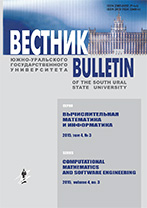|
Two-dimensional model of facet vision
R. S. Fedyanina, L. B. Sokolinsky
South Ural State University (pr. Lenina 76, Chelyabinsk, 454080 Russia)
Abstract:
One of the modern promising areas of research in the field of machine vision is visualization systems based on artificial compound eyes, which are based on the principles of organizing insect vision. Such eyes have a complex structure, the main elements of which are visual elements called ommatidium. In this paper, we construct a mathematical model of binocular facet vision in two-dimensional space. This model allows you to describe the tasks of navigating a robotic device and detecting objects on a plane. In the proposed model, the faceted eye is a regular polygon with a 360° view. The main parameters of the model are the number of facets (ommatidia) in one eye, the radius of the circle described around the eye, and the distance between the eyes. The model assumes that the ommatidia fields of view of one eye do not intersect. Circles of various diameters appear as observed objects. We derive the formula for determining the number of ommatidium in which the point with the specified coordinates falls. We prove a theorem on the necessary and sufficient condition for a given circle to fall into the field of view of an ommatidium with a given number. An algorithm for constructing a training sample for an artificial neural network based on a two-dimensional facet vision model is proposed.
Keywords:
visualization systems, mathematical model of facet vision, neural network, training sample generation.
Received: 26.10.2020
Citation:
R. S. Fedyanina, L. B. Sokolinsky, “Two-dimensional model of facet vision”, Vestn. YuUrGU. Ser. Vych. Matem. Inform., 9:4 (2020), 48–66
Linking options:
https://www.mathnet.ru/eng/vyurv246 https://www.mathnet.ru/eng/vyurv/v9/i4/p48
|

| Statistics & downloads: |
| Abstract page: | 139 | | Full-text PDF : | 87 |
|




 Contact us:
Contact us: Terms of Use
Terms of Use
 Registration to the website
Registration to the website Logotypes
Logotypes








 Citation in format
Citation in format 